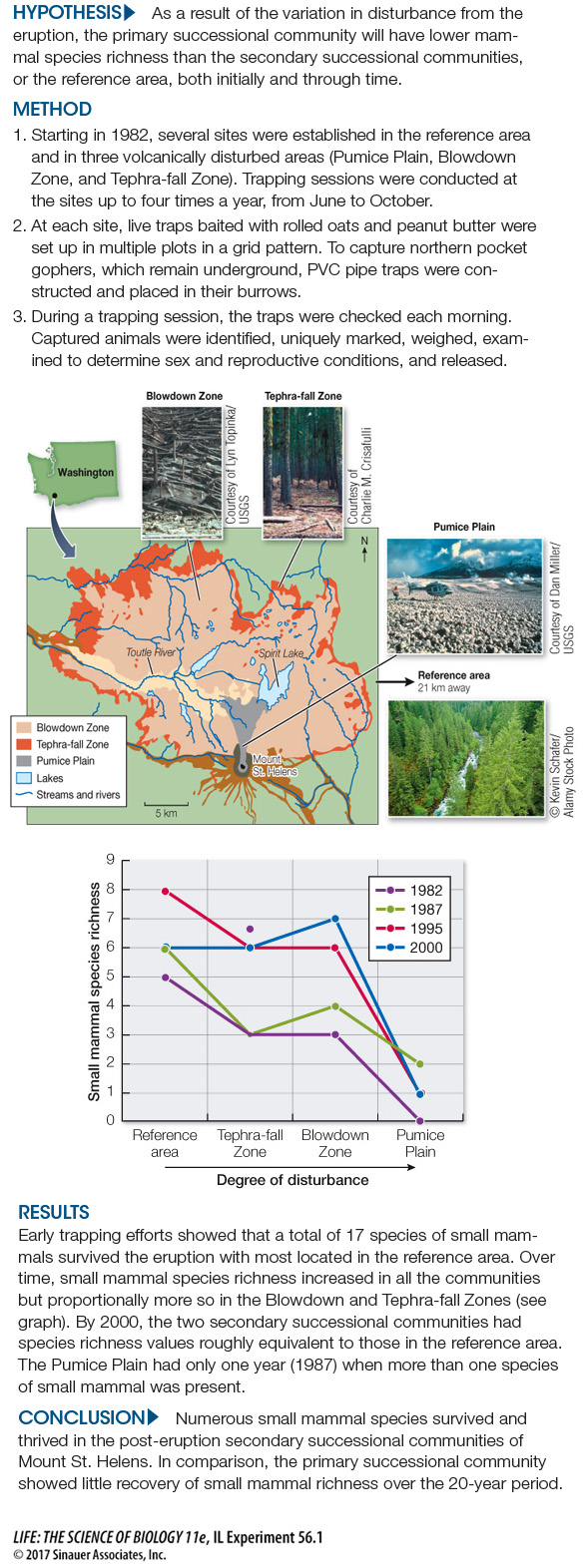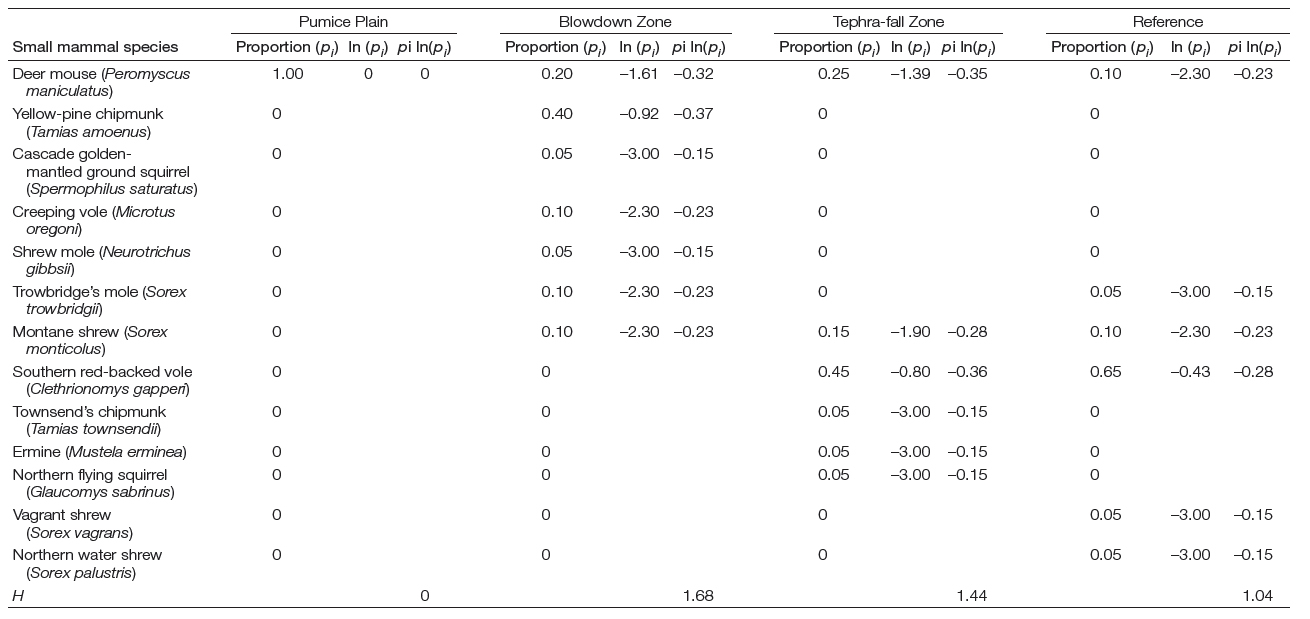Succession is a process of change in communities over time
Traditionally ecologists have viewed succession as a progression of stages in which species come and go until a climax community arises. The climax community is thought to be a stable assemblage of species that experiences little change until an intense disturbance wipes out the community, sending it back to its initial stages again. As you will see later in this section, whether some communities reach a true stable end point is questionable. Let’s consider the mechanics of succession in more detail.
Succession is probably most easily observed after a catastrophic disturbance kills all the organisms in a community, leaving an environment devoid or nearly devoid of life. This type of change is known as primary succession. Glaciers, volcanic activity, and in some cases floods or landslides cause disturbance that initiates primary succession. Primary succession by its very nature can be slow because the early arrivals (known as pioneer or early successional species) must deal with extreme conditions. Many pioneer species deal with these conditions by employing certain *life history strategies or species interactions to their favor.
*connect the concept Life history strategies are the lifetime patterns of growth, reproduction, and survival of a species (see Key Concept 54.3). Pioneer species tend to have life history strategies that maximize population growth (r-strategists).
One of the best-

Question
Q: Based on the locations of the glaciers over time, indicate where the oldest and youngest communities (black dots) are located.
The oldest communities are located in the areas that have been exposed the longest since glacial retreat, such as the mouth of the bay, where succession has proceeded for 200 years. As the glaciers melt and retreat up the bay, the communities become younger and younger, with the youngest pioneer community closest to the glacial front.
Animation 56.1 Primary Succession on a Glacial Moraine
www.life11e.com/
Nitrogen is virtually absent from glacial moraines, so the plants that grow best on recently formed moraines at Glacier Bay are Dryas and alders, both of which have nitrogen-
1218
On Mount St. Helens, ecologists have had a unique opportunity to study primary succession from its inception. As described in the opening story, the alpine communities surrounding the lava dome experienced the greatest destruction; they were the first to be hit by an avalanche of mud and hot water and then pelted by hot, sterilizing pumice. This created the so-
A surprising discovery about primary succession on Mount St. Helens was the important role of animals in directing change. For example, scientists observed that newly formed and isolated ponds and lakes were colonized by amphibians at a faster rate than one might predict given the surrounding harsh conditions. Ecologists discovered that frogs and salamanders were using tunnels created by the northern pocket gopher (Thomomys talpoides) as refuges when they made their way from pond to pond across the dry landscape (Figure 56.16). Pocket gophers successfully survived the eruption by living in tunnels under the mud. They also benefitted by the expansion of their preferred habitat—

Question
Q: Are pocket gophers keystone species, foundation species, and/or ecosystem engineering species?
Pocket gophers most closely fit the ecosystem engineering species definition because they are able to create, modify, and/or maintain physical habitat for themselves and other species through their burrowing activities. They might also be considered a keystone species because their effect is large relative to their size and abundance. However, keystone species are thought to act mostly through food webs by creating trophic cascades.
The other type of succession, known as secondary succession, involves the reestablishment of a community when most, but not all, organisms have been destroyed. Secondary succession is often initiated by human activities (such as clear cutting) as well as by natural disasters (such as storms and fires). Secondary succession is more common and it progresses more rapidly than primary succession. For example, even though the eruption of Mount St. Helens completely destroyed some areas near the blast zone, there were large areas where organisms survived and secondary succession took place.
1219
investigating life
Rising from the Ashes
experiment
Original Paper: Crisafulli, C. M., J. A. MacMahon and R. R. Parmenter. 2005. Small mammal survival and colonization on the Mount St. Helens Volcano: 1980–
Charles Crisafulli and his colleagues were some of the first ecologists to study the successional processes on Mount St. Helens after the eruption. They concentrated on the recovery of small mammals in three types of communities that the eruption had disturbed in different ways: a primary successional community named the Pumice Plain, which experienced complete destruction of all living things, and two secondary successional communities: the Blowdown Zone, in which trees fell and the area was covered in mud but some life remained underground, and the Tephra-

work with the data
In addition to examining small mammal species richness, Crisafulli and his team were interested in the composition of those species and their abundance—
| Proportion of individuals | ||||
|---|---|---|---|---|
| Small mammal species | Pumice Plain | Blowdown Zone | Tephra- |
Reference area |
| Deer mouse (Peromyscus maniculatus) | 1.00 | 0.20 | 0.25 | 0.10 |
| Yellow- |
0 | 0.40 | 0 | 0 |
| Cascade golden- |
0 | 0.05 | 0 | 0 |
| Creeping vole (Microtus oregoni) | 0 | 0.10 | 0 | 0 |
| Shrew mole (Neurotrichus gibbsii) | 0 | 0.05 | 0 | 0 |
| Trowbridge’s mole (Sorex trowbridgii) | 0 | 0.10 | 0 | 0.05 |
| Montane shrew (Sorex monticolus) | 0 | 0.10 | 0.15 | 0.10 |
| Southern red- |
0 | 0 | 0.45 | 0.65 |
| Townsend’s chipmunk (Tamias townsendii) | 0 | 0 | 0.05 | 0 |
| Ermine (Mustela erminea) | 0 | 0 | 0.05 | 0 |
| Northern flying squirrel (Glaucomys sabrinus) | 0 | 0 | 0.05 | 0 |
| Vagrant shrew (Sorex vagrans) | 0 | 0 | 0 | 0.05 |
| Northern water shrew (Sorex palustris) | 0 | 0 | 0 | 0.05 |
QUESTIONS
Question 1
Using the data in the table above, calculate the species diversity of each of the post-

The Pumice Plain had the lowest species diversity (H = 0) and the Blowdown Zone had the highest species diversity (H = 1.68). The Pumice Plain had the lowest species richness (1 species) compared to the Blowdown Zone, which had the highest species richness (7 species). The Reference and the Tephra-
Question 2
Plot species diversity versus the degree of disturbance from the eruption for the four communities. How well do the data fit the intermediate disturbance hypothesis (see Figure 56.10)? Explain.

The species diversity data for small mammals seem to fit the intermediate disturbance hypothesis well. As the degree of disturbance experienced by the four community types increases, so does species diversity of small mammals in those communities, up to a point—
The pattern of species diversity seen in small mammals in the Tephra-
Question 3
Consider the presence or absence of particular species in the four communities. Which species is present in all the communities? What does that suggest about its life history?
The deer mouse (Peromyscus maniculatus) is the only species present in all four communities. This suggests that the deer mouse has a life history that allows it to live in primary, secondary, and climax successional communities. It is likely able to disperse widely, growth quickly, and reproduce often—
Question 4
The Blowdown Zone, Tephra-
The Tephra-
A similar work with the data exercise may be assigned in LaunchPad.
Ecologists compared primary and secondary succession on Mount St. Helens by following small mammals in the community. As we mentioned in the chapter opening, different Mount St. Helens communities experienced different levels of disturbance from the eruption. Investigating Life: Rising from the Ashes describes research by Charles Crisafulli and colleagues at the USDA Forest Service, showing that the recovery of small mammal populations on Mount St. Helens varied significantly between primary and secondary successional habitats. The Pumice Plain (primary successional habitat completely devoid of life after the eruption) had the lowest species richness of small mammals, a pattern that persisted for at least 20 years. In contrast, small mammal populations recovered relatively quickly in the Blowdown Zone and the Tephra-